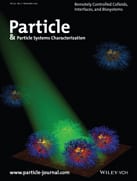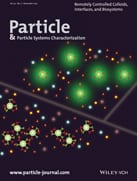With 2013 rapidly drawing to a close I would like to draw the first topical Special Issue of Particle & Particle Systems Characterization to your attention. Guest edited by Gleb Sukhorukov, Igor Luzinov, and Sergiy Minko the November issue entitled Remotely Controlled Colloids, Interfaces, and Biosystems highlights “a number of recently opened possibilities to generate functional colloids, which combine two or more functionalities when at least one of them is sensitive to remotely controlled signals.”
 The issue contains eleven excellent contributions, which are accessible for free for a limited period of time on Wiley Online Library. The front cover illustrates “hairy” gold nanoparticles modified with block copolymers. Svetlana A. Sukhishvili and co-workers from the Stevens Institute of Technology in Hoboken, New Jersey discuss how these particles can be applied to control the wettability of interfaces by changes in solution pH, temperature, or through illumination by laser light. The back cover, which shows conjugated polymer nanoparticles with Ag+-sensitive fluorescence emission represents the work of Zhiyuan Tian and co-workers based in China.
The issue contains eleven excellent contributions, which are accessible for free for a limited period of time on Wiley Online Library. The front cover illustrates “hairy” gold nanoparticles modified with block copolymers. Svetlana A. Sukhishvili and co-workers from the Stevens Institute of Technology in Hoboken, New Jersey discuss how these particles can be applied to control the wettability of interfaces by changes in solution pH, temperature, or through illumination by laser light. The back cover, which shows conjugated polymer nanoparticles with Ag+-sensitive fluorescence emission represents the work of Zhiyuan Tian and co-workers based in China.
 Janus particles are a type of nanoparticle with two faces that display two or more distinct physical properties. Ionov and Synytska review the literature in this field and discuss how these particles respond to various stimuli such as a change in temperature, pH or light. Janus particles is also the topic of a Communication article by Joerg Lahann and co-workers, in which inorganic Janus particles are prepared by electro-hydrodynamic co-jetting of mixtures of organic polymers and inorganic precursors. This approach creates biocompartmental SiO2 particles with iron oxide nanocrystals selectively loaded into one hemisphere. Further research in this area may ultimately lead to the practical application of these particles in catalysis, display technologies or energy research. A Full Paper contribution from Park and co-workers rounds up the focus on Janus particles by presenting a method involving microfluidics and directional UV curing that enables the simple fabrication of asymmetric porous polymer particles functionalized with metal nanoparticles.
Janus particles are a type of nanoparticle with two faces that display two or more distinct physical properties. Ionov and Synytska review the literature in this field and discuss how these particles respond to various stimuli such as a change in temperature, pH or light. Janus particles is also the topic of a Communication article by Joerg Lahann and co-workers, in which inorganic Janus particles are prepared by electro-hydrodynamic co-jetting of mixtures of organic polymers and inorganic precursors. This approach creates biocompartmental SiO2 particles with iron oxide nanocrystals selectively loaded into one hemisphere. Further research in this area may ultimately lead to the practical application of these particles in catalysis, display technologies or energy research. A Full Paper contribution from Park and co-workers rounds up the focus on Janus particles by presenting a method involving microfluidics and directional UV curing that enables the simple fabrication of asymmetric porous polymer particles functionalized with metal nanoparticles.
In other short Communications Petra Uhlmann and co-workers show how quartz crystal microbalance combined with spectroscopic ellipsometry can be used to synthesize nanocatalytic coatings, Joachim Spatz and co-workers outline a simple method to pattern glass beads with gold nanoparticles that could potentially be used to produce nanoparticle-supported catalysts or biosensors, and Patanè, Turyanska and co-workers report on cytotoxicity studies using paramagnetic nanoparticles with a view to the application of these particles in medical imaging.
Three Full Paper contributions complete the special issue. Kornev and Gu present a theoretical study on the kinetics of ordering of an assembly of nanorods suspended in a solidifying liquid film. Magnetomicelles, which are amphiphilic block co-polymer micelles that contain magnetic nanoparticles in the core, is the focus of the work reported by Rinaldi and Olayo-Valles. Potential application lies in the area of drug delivery for cancer treatment. Finally, Sukhorukov and Yi discuss the fabrication of polyelectrolyte microcapsules using layer-by-layer assembly. These sealed capsules demonstrate excellent ability for small molecule encapsulation, as proven by successful rhodamine B entrapment in the capsule cavities.
In closing, I would like to invite you to access this Special Issue of Particle, available to access for free for a limited time. As so eloquently put by the guest editors “We believe that a number of exciting applications for remotely controlled systems could be extended to new fields, technologies, and materials. We are grateful to all contributors of the special issue for their excellent scholarly articles. We believe that this special issue of Particle will nucleate a new round of research activity in the field of remotely controlled colloids and interfaces, including biologically related systems.” Read the full Editorial here.
 Gleb Sukhorukov is Professor of Biomaterials at the School of Engineering and Materials Science, Queen Mary University of London (QMUL), UK. He received a doctorate degree in biophysics from the Department of Physics, Lomonosov Moscow State University in 1994. In 2001, he started his own research group at the Max Planck Institute of Colloids and Interfaces (Potsdam, Germany), where he stayed until he joined QMUL in 2005. His research comprises design of multifunctional colloidal particles and capsules and nano-engineered biomaterials. He pioneered research into layer-by-layer assembly on colloidal particles and fabrication of capsules.
Gleb Sukhorukov is Professor of Biomaterials at the School of Engineering and Materials Science, Queen Mary University of London (QMUL), UK. He received a doctorate degree in biophysics from the Department of Physics, Lomonosov Moscow State University in 1994. In 2001, he started his own research group at the Max Planck Institute of Colloids and Interfaces (Potsdam, Germany), where he stayed until he joined QMUL in 2005. His research comprises design of multifunctional colloidal particles and capsules and nano-engineered biomaterials. He pioneered research into layer-by-layer assembly on colloidal particles and fabrication of capsules.
 Igor Luzinov is Professor of Polymer Science in the Department of Materials Science and Engineering at Clemson University, SC, USA. Dr. Luzinov received a Ph.D. degree in Chemistry in 1990 from the Lviv Polytechnic National University, Ukraine. Before joining Clemson University in 2000, he served as a Senior Research Scientist at the Physical Chemistry Institute, National Academy of Science of Ukraine, as a NATO Research Fellow at the University of Liege, Belgium, and a a Postdoctoral Associate at Iowa State and Western Michigan Universities, USA. Dr. Luzinov’s research focuses on fundamental and applied research problems in nanofabrication of thin polymer films.
Igor Luzinov is Professor of Polymer Science in the Department of Materials Science and Engineering at Clemson University, SC, USA. Dr. Luzinov received a Ph.D. degree in Chemistry in 1990 from the Lviv Polytechnic National University, Ukraine. Before joining Clemson University in 2000, he served as a Senior Research Scientist at the Physical Chemistry Institute, National Academy of Science of Ukraine, as a NATO Research Fellow at the University of Liege, Belgium, and a a Postdoctoral Associate at Iowa State and Western Michigan Universities, USA. Dr. Luzinov’s research focuses on fundamental and applied research problems in nanofabrication of thin polymer films.
 Sergiy Minko is Egon Matijevic Chaired Professor of Chemistry at the Department of Chemistry and Biomolecular Science, Clarkson University, NY, USA. Dr. Minko received his D.Sc. in chemistry from the National Academy of Sciences of Ukraine in 1993. Between 1997 and 1998, Sergiy Minko was an Alexander von Humboldt Research Fellow at the University of Ulm, Germany. Before joining Clarkson in 2003, he held a senior research position at the Leibniz Institute of Polymer Research, Dresden, Germany. His research is in the fields of stimuli-responsive materials, thin polymer films, polymer brushes, polymer gels, fibers and membranes, colloidal particles, and self-assembly.
Sergiy Minko is Egon Matijevic Chaired Professor of Chemistry at the Department of Chemistry and Biomolecular Science, Clarkson University, NY, USA. Dr. Minko received his D.Sc. in chemistry from the National Academy of Sciences of Ukraine in 1993. Between 1997 and 1998, Sergiy Minko was an Alexander von Humboldt Research Fellow at the University of Ulm, Germany. Before joining Clarkson in 2003, he held a senior research position at the Leibniz Institute of Polymer Research, Dresden, Germany. His research is in the fields of stimuli-responsive materials, thin polymer films, polymer brushes, polymer gels, fibers and membranes, colloidal particles, and self-assembly.

















